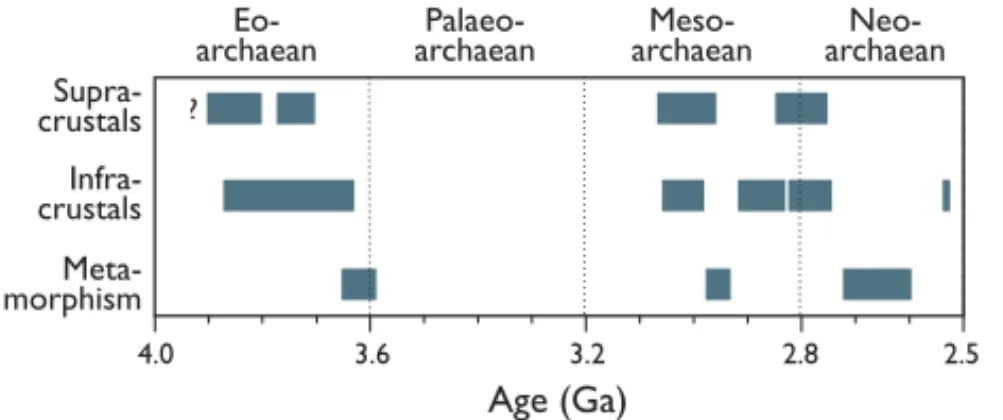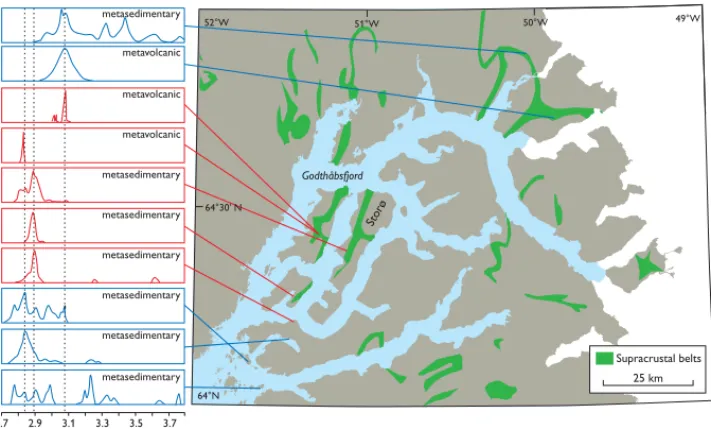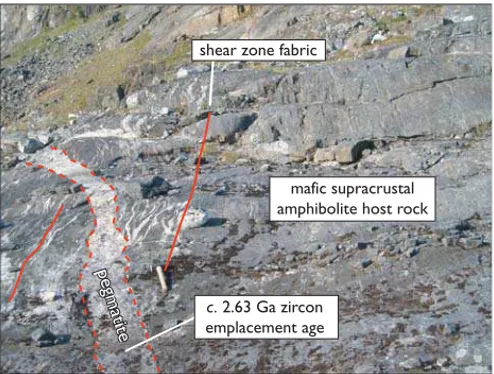Until recently, in situU-Pb zircon geochronology could be
carried out only using ion microprobes, requiring lengthy analysis times of c. 20 minutes. However, new developments in
laser ablation inductively coupled plasma mass spectrometer technologies have resulted in zircon geochronology tech-niques that are much faster, simpler, cheaper, and more pre-cise than before (e.g. Frei et al. 2006, this volume). Analyses
approaching the precision obtained via ion microprobe can now be undertaken in 2–4 minutes using instruments such as the 213 nm laser ablation (LA) system coupled with Element2 sector-field inductively coupled plasma mass spec-trometer (SF-ICP-MS) housed at the Geological Survey of Denmark and Greenland (GEUS). The up to tenfold decrease in analytical time means that zircon geochronology can now be used in a much wider range of studies.
The Godthåbsfjord region, southern West Greenland, contains some of the oldest rocks exposed on the Earth’s sur-face reflecting a very complex Archaean geological evolution (Figs 1, 2). Over recent years GEUS has undertaken a range of mapping projects at various scales within the Godt-håbsfjord region (see also below). These include the mapping of the 1:100 000 scale Kapisillit geological map sheet (Fig. 1), and regional and local investigations of the environments of
formation and geological evolution of supracrustal belts, hosting potentially economic mineral occurrences.
Zircon geochronology is an important tool for investigat-ing a range of geological problems in this region. By breakinvestigat-ing down the complex geology into a series of simple problems that can be addressed using this tool, the geological evolution can be unlocked in a stepwise manner. Three examples are presented below: (1) the mapping of regional structures; (2) characterising and correlating supracrustal belts; and (3) dating metamorphism and mineralisation. Although focus is on the application of zircon geochronology to these problems, it is important to note that the resulting data must always be viewed within a wider context incorporating geological mapping and structural, geochemical and petrographic inves-tigations.
Regional geology
The geology of the Godthåbsfjord region is dominated by orthogneiss formed during several distinct episodes of crustal growth during the Archaean (Fig. 2). These different-aged gneisses are thought to represent distinct small continental blocks that were amalgamated during the Neoarchaean (at
© GEUS, 2006. Geological Survey of Denmark and Greenland Bulletin 10, 49–52. Available at: www.geus.dk/publications/bull
Using zircon geochronology to resolve the
Archaean geology of southern West Greenland
Julie A. Hollis, Dirk Frei, Jeroen A.M. van Gool, Adam A. Garde and Mac Persson
49 Fig.3
c. 3.87-3.6 Ga
c. 3.0-2.98 Ga
c. 3.2-2.98 Ga
c. 3.87-3.6 Ga &
c. 2.835-2.75 Ga
c. 2.92-2.84 Ga
Greenland
Supracrustal belts Terrane boundary
25 km
Nuuk
Storø Kapisillit
64°N
51°W
52°W 50°W
64°30' N
Godthåbsfjord
Ameralla
Ameralik
Fig. 1. Overview map of the Godthåbsfjord region. Inset shows the location of the main map in Greenland. Supracrustal belts are shown ingreen. The boundaries of the 1:100 000 scale Kapisillit geological map sheet area are inred.Blue linesoutline the area shown in
Fig. 3. Bold black linesare inferred terrane
c. 2.7–2.6 Ga) during collisional tectonism (similar to that
seen in modern mountain belts). Within, and often between, these different crustal blocks, or terranes, supracrustal belts made up of metasedimentary and metavolcanic rocks occur. Some of these are known to host potentially economic min-eral occurrences, e.g. gold-minmin-eralised supracrustal rocks on the island Storø (Fig. 1).
Several high-grade metamorphic events and associated deformation have affected different parts of the region from the Palaeoarchaean through to the Neoarchaean. These events resulted in partial melting, variable development of high-strain structural fabrics, and several generations of large-scale folds.
Mapping major regional structures
Although the orthogneisses that dominate the geology of the region were formed during several distinct events, different generations of orthogneisses are often very difficult to distin-guish in the field owing to their similarity of composition (Fig. 3). The geometry of supracrustal belts is very useful in identifying the nature of regional structures, as these are lithologically very different from the orthogneisses and can be used as structural markers. However, where these are absent reconnaissance geochronology can be applied. Having identified several of the main crust-forming events in the region, it is possible to use the emplacement ages of orthogneisses as a guide to field mapping and the delineation of large-scale structures.
Selected samples collected during the 2004 field mapping were dated using LA-SF-ICP-MS U-Pb zircon geochrono-logy (Fig. 2). Major fold structures inferred from field map-ping data were dated using this method, in some cases resulting in significant advances in understanding. So far the results indicate that Mesoarchaean rocks were thrust north-wards over Neo- and Eo- to Palaeoarchaean rocks and then deformed in kilometre-scale refolded folds (Fig. 3). The resulting map was used to identify problematic areas to inves-tigate during the 2005 mapping.
Identifying and correlating
supracrustal belts
Figure 1 shows the distribution of known supracrustal belts in the Godthåbsfjord region, typically comprising high-grade metamorphic volcanic, ultramafic, subordinate aluminous and siliceous sedimentary rocks. These were once thought to represent a single, dismembered suite of Mesoarchaean supracrustal rocks. It is now known that there are in fact sev-eral distinct belts deposited at c. 3.87 and 3.7 Ga (the Isua
supracrustal belt), c. 3.0 Ga, and at c. 2.8 Ga (Fig. 2). These
belts commonly occur along tectonised boundaries between chronologically distinct terranes.
Correlation between different supracrustal belts is impor-tant for understanding the regional structures and identifying areas of potentially economic mineral occurrences. Some belts show lithological and geochemical differences, and sim-ilarities that can be used to compare and contrast them. These indicate that there are at least three different environ-ments that were important in forming the different belts: (1) basic volcanism in extensional oceanic environments; (2) gabbro-anorthosite magmatism at deeper levels within oceanic crust; and (3) andesitic volcanism and associated hydrothermal syngenetic alteration in island-arc environ-ments (Garde 2005; Hollis 2005). However, the majority of
3.2
3.6 2.5
4.0
Age (Ga)
2.8
Eo-archaean archaeanPalaeo- archaeanMeso- archaean
Neo-?
Supra-crustals Infra-crustals Meta-morphism
Fig. 2. Simplified summary of the major thermal events in the Godt-håbsfjord region.
1
2
2 1
Eo- to Palaeoarchaean (3.7-3.5 Ga) Early Mesoarchaean (3.2-2.9 Ga) Late Mesoarchaean
(2.9-2.85 Ga) Neoarchaean (2.85-2.75 Ga)
Unknown age
Colour-coded dated samples
First generation folds Second generation folds
Kangersuneq
Kapisillit
Ameralla
10 km
Fig. 3. Simplified version of map of major fold structures in the Kapisillit
1:100 000 scale geological map area. Coloured circlesindicate the sites
where zircons from rock samples have been dated. The fill colours
indi-cate the obtained ages. These ages have been used to constrain the sur-face geometry of the folds. Photographs of outcrops of orthogneiss from two localities show that rocks of very similar appearance can be very dif-ferent ages and therefore geochronology is useful in distinguishing them.
the belts are strongly tectonised and extensive recrystallisa-tion occurred during high-grade metamorphism. Locally hydrothermal alteration is very intense. Therefore, the pro-toliths are difficult to recognise and the different supracrustal belts are difficult to distinguish without detailed geochemical and geochronological information.
One of the most important tools for correlation is the study of detrital zircons. Siliceous and aluminous metasedi-mentary rocks carry detrital zircons derived from the erosion of the source regions for the sediments. Thus studies of their detrital zircons allow an assessment of both likely sources and their maximum age of deposition (given by the youngest detrital zircon). Furthermore, the detrital zircon age spec-trum of a metasedimentary rock from a specific supracrustal belt is often characteristic, as the zircons are typically derived from the same source area. The detrital spectra can therefore be used to correlate between widely spaced supracrustal belts that would otherwise be difficult to compare from petro-graphic or geochemical data alone.
A compilation of existing and recently obtained detrital zircon data for metasedimentary rocks and primary zircons from metavolcanic or volcanoclastic rocks in the Godthåbs-fjord region is shown in Fig. 4 (see also Hollis 2005). Distinct sources for supracrustal rocks of different ages are readily apparent. The volcanic rocks that form part of the Meso-archaean supracrustal belts were deposited at c. 3.07 Ga,
which is just slightly older than the dominant Mesoarchaean regional orthogneiss. Similarly, metasedimentary rocks with-in the Mesoarchaean supracrustal belts show domwith-inant zircon age peaks at c. 3.07 Ga. However, significant proportions of
older zircons show that there was also a contribution from Palaeo- and Eoarchaean sources. The Neoarchaean volcanic rocks were deposited at c. 2.83 Ga, which is also an age that
is well represented in the detrital zircon population of most of the Neoarchaean metasedimentary rocks. A few metasedi-mentary samples show relatively minor contributions from older Meso- to Eoarchaean material. The synchronous sedi-mentation and generation of volcanic material at c. 3.07 Ga
(Mesoarchaean) and at c. 2.83 Ga (Neoarchaean) suggests there
may have been a common tectonic environment operating at both times.
When did metamorphism
and mineralisation occur?
The Godthåbsfjord region records a complex history of high-grade metamorphism, which affected different parts of the Godthåbsfjord region at different times, from c. 3.8–2.5 Ga.
The record of particular metamorphic events in different parts of the region has been used to establish the times when different terranes were amalgamated via collisional tectonism (e.g. Friend & Nutman 2005). The timing of metamorphism and contemporaneous deformation has also been used to constrain the timing of mineralisation events.
On Storø in central Godthåbsfjord (Fig. 1) detailed stud-ies of the nature and timing of gold mineralisation have been carried out. Here gold-mineralised strataform horizons and cross-cutting quartz veins occur within a Neoarchaean supra-crustal belt that was deposited at or after 2.8 Ga. The gold-bearing horizons are deformed by the kilometre-wide, high-grade Storø shear zone; thus the generation of the shear fabric post-dates the gold-mineralising event. To place absolute constraints on the timing of gold mineralisation the timing of emplacement of some of the abundant granitic peg-matites that either cross-cut or are deformed by the shear fab-ric has been investigated (Fig. 5). Four pegmatites contained
51 Supracrustal belts
25 km
Storø
64°N
52°W 51°W 50°W 49°W
Godthåbsfjord
2.7 2.9 3.1 3.3 3.5 3.7 Ga
64°30' N metavolcanic
metasedimentary
metasedimentary
metasedimentary
metasedimentary
metasedimentary
metasedimentary metavolcanic metasedimentary
metavolcanic Fig. 4. Detrital zircon populations linked
to the distribution of supracrustal belts. Inset shows the location of the main map
in Greenland.Redzircon spectra were
collected using the GEUS LA-SF-ICP-MS.
Bluezircon spectra are taken from
Nut-manet al.(2004) and Schiøtte et al. (1988).
52
igneous zircon crystallised at c. 2.63–2.60 Ga. This is the
same age as yielded by metamorphic zircons separated from a leucocratic amphibolite, and from metamorphic overgrowths on detrital zircons taken from a melt layer within a migma-tised metasedimentary rock, both within the same supracrustal sequence on Storø. These results show that a gold-mineralising event occurred within the Neoarchaean supracrustal belt during or after sedimentation at c. 2.8 Ga and before the formation
of the Storø shear zone during high-grade metamorphism and partial melting at c. 2.63 Ga. These results constrain the
timing of mineralisation and may be extended to the investi-gation of rocks of similar age and setting elsewhere in the region.
Further work
This work forms part of ongoing studies of the supracrustal belts in the Godthåbsfjord region carried out with support from the Greenland Bureau of Minerals and Petroleum. In addition to the examples given here, the GEUS LA-SF-ICP-MS system can also be used to investigate the cooling history of rocks via U-Pb dating of zircon and other minerals, includ-ing titanite and monazite. Furthermore, by explorinclud-ing other aspects of zircon geochemistry, such as Hf and O isotopes it may also be possible to delve deeper into issues of crustal evo-lution of the North Atlantic Craton through the Archaean.
References
Garde, A.A. 2005: A mid-Archaean island arc complex with gold miner-alisation at Qussuk, Akia terrane, southern West Greenland. In: Hollis, J.A. (ed.): Greenstone belts in the central Godthåbsfjord region, south-ern West Greenland: Geochemistry, geochronology and petrography arising from 2004 field work, and digital map data. Danmarks og
Grønlands Geologiske Undersøgelse Rapport 2005/42, 215 pp., 1 DVD.
Hollis, J.A. (ed.) 2005: Greenstone belts in the central Godthåbsfjord region, southern West Greenland: Geochemistry, geochronology and petrography arising from 2004 field work, and digital map data.
Danmarks og Grønlands Geologiske Undersøgelse Rapport 2005/42,
215 pp., 1 DVD.
Frei, D., Hollis, J.A., Gerdes, A., Harlov, D., Karlsson, C., Vasquez, P.,
Franz, G. & Knudsen, C. 2006: Advanced in situgeochronological and
trace element microanalysis by laser ablation techniques. Geological
Survey of Denmark and Greenland Bulletin 10, 25–28.
Friend, C.R.L. & Nutman, A.P. 2005: New pieces to the Archaean terrane jigsaw puzzle in the Nuuk region, southern West Greenland: Steps in transforming a simple insight into a complex regional tectonothermal
model. Journal of the Geological Society (London) 162, 147–162.
Nutman, A.P., Friend, C.R.L., Barker, S.L.L. & McGregor, V.R. 2004: Inventory and assessment of Palaeoarchaean gneiss terraines and detrital zircons in southern West Greenland. Precambrian Research
135, 281–314.
Schiøtte, L., Compston, W. & Bridgwater, D. 1988: Late Archaean ages for the deposition of clastic sediments belonging to the Malene supra-crustals, southern West Greenland: evidence from an ion probe U-Pb
zircon study. Earth and Planetary Science Letters 87, 45–58.
Authors’ addresses
J.A.H., D.F., J.v.G., A.A.G.,Geological Survey of Denmark and Greenland, Øster Voldgade 10, DK-1350 Copenhagen K, Denmark. E-mail: jho@geus.dk
M.P., University of Copenhagen, Øster Voldgade 10, DK-1350 Copenhagen K.
mafic supracrustal amphibolite host rock
pegmatite pegmatite pegmatite
c. 2.63 Ga zircon emplacement age shear zone fabric
Fig. 5. Pegmatite on Storø cross-cutting and deformed by the Storø shear zone fabric, and Neoarchaean supracrustal amphibolite host rock.
Zircons from the pegmatite indicate it was formed at c. 2.63 Ga, placing


